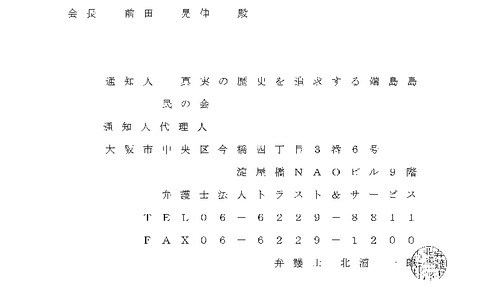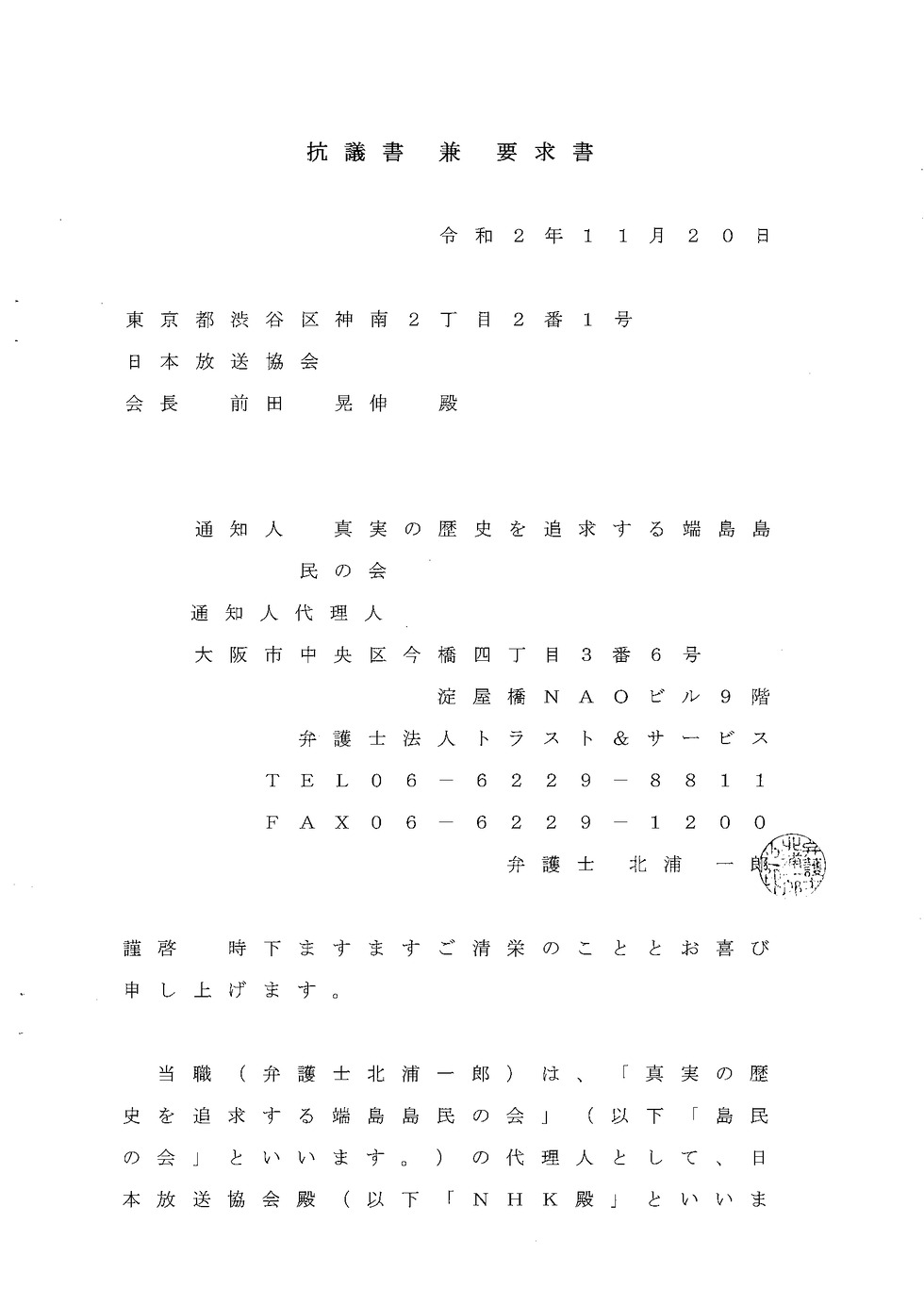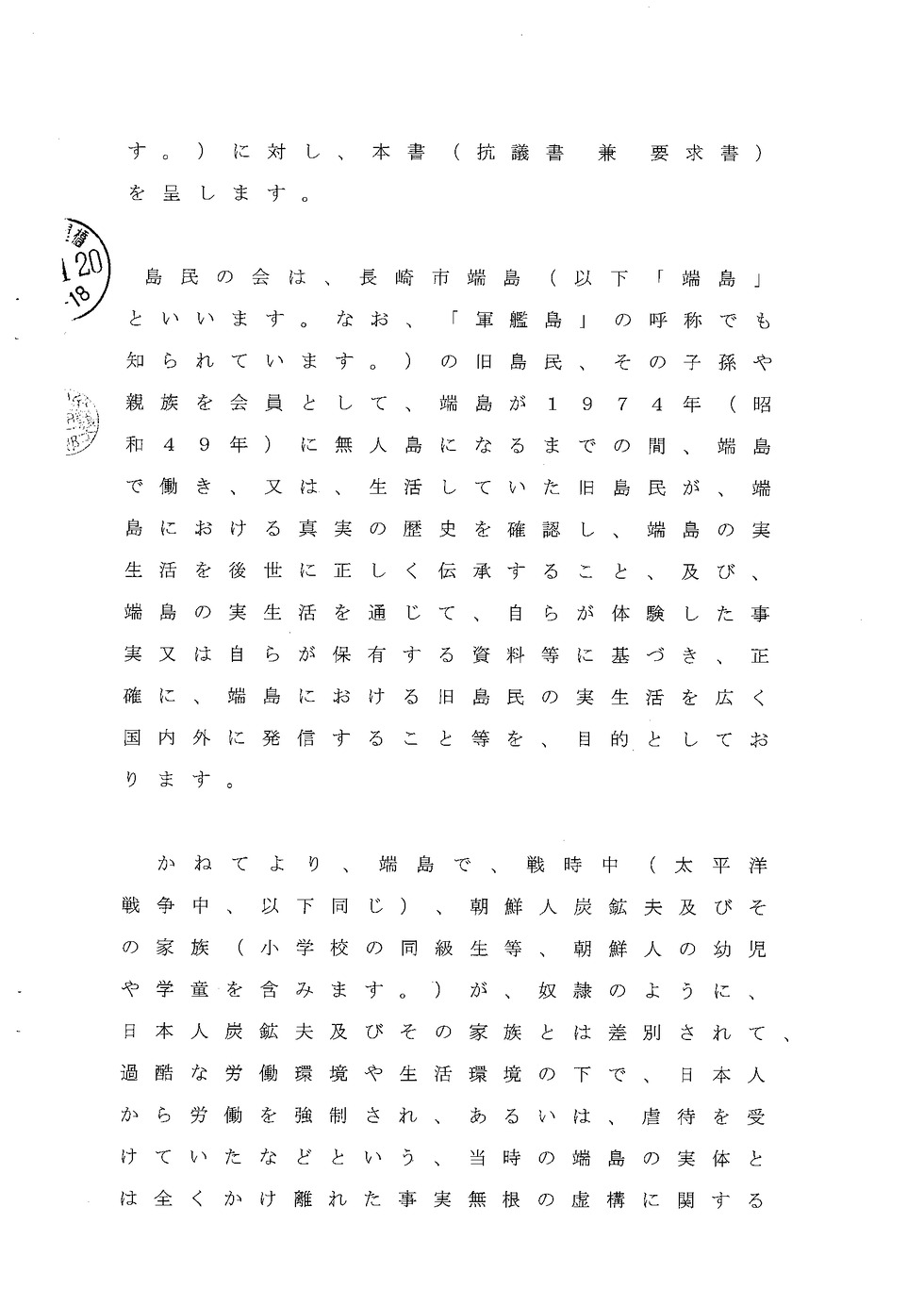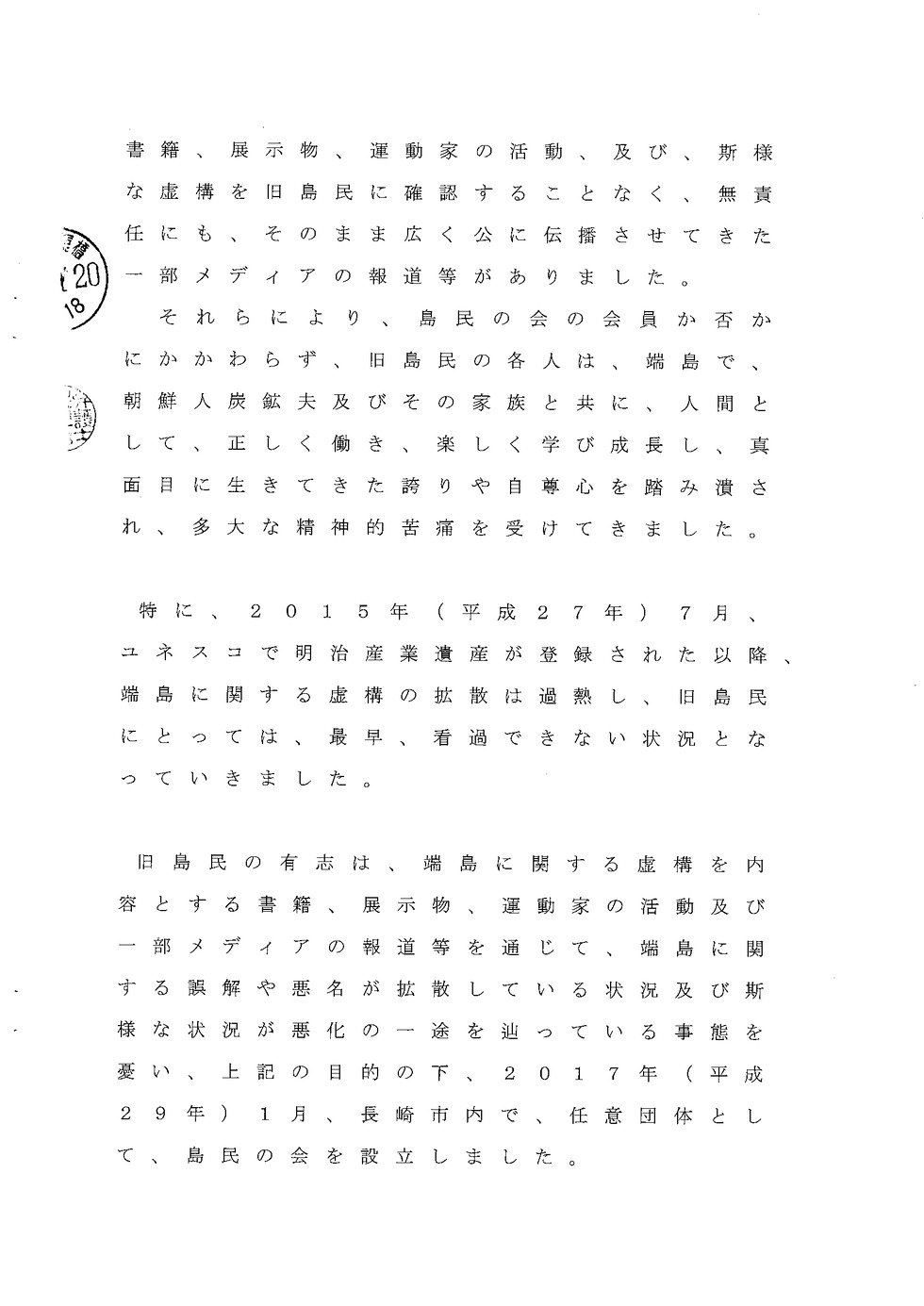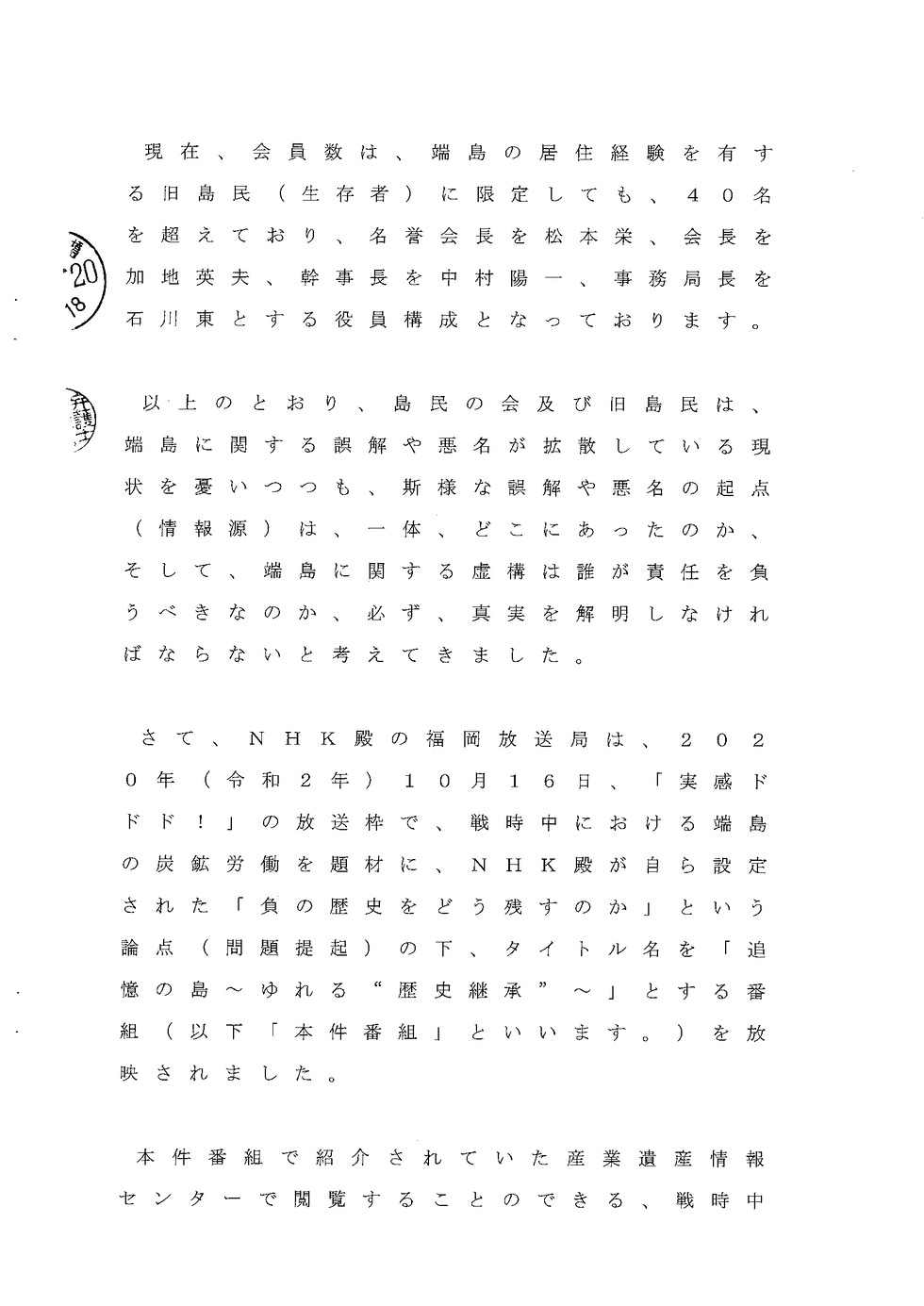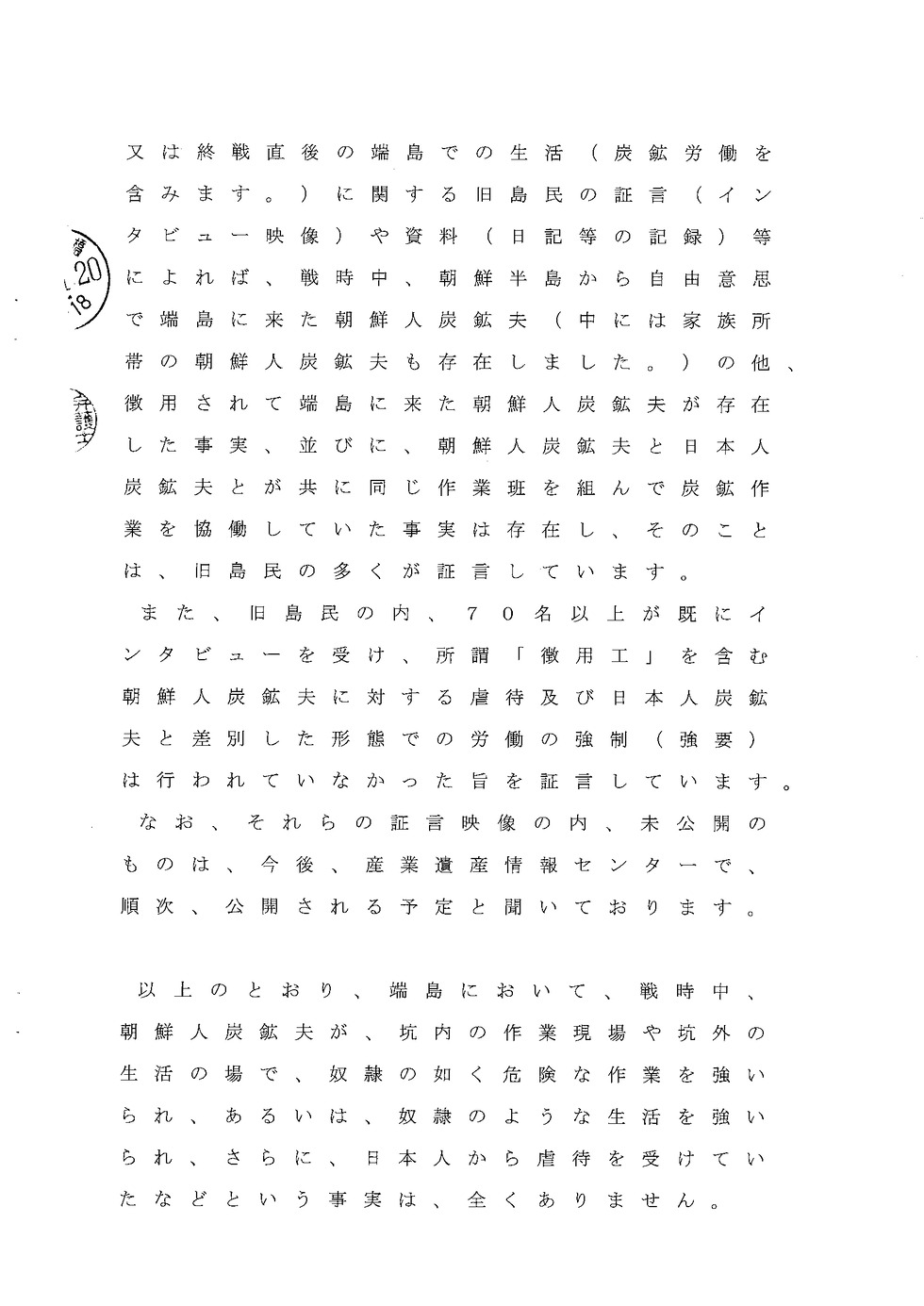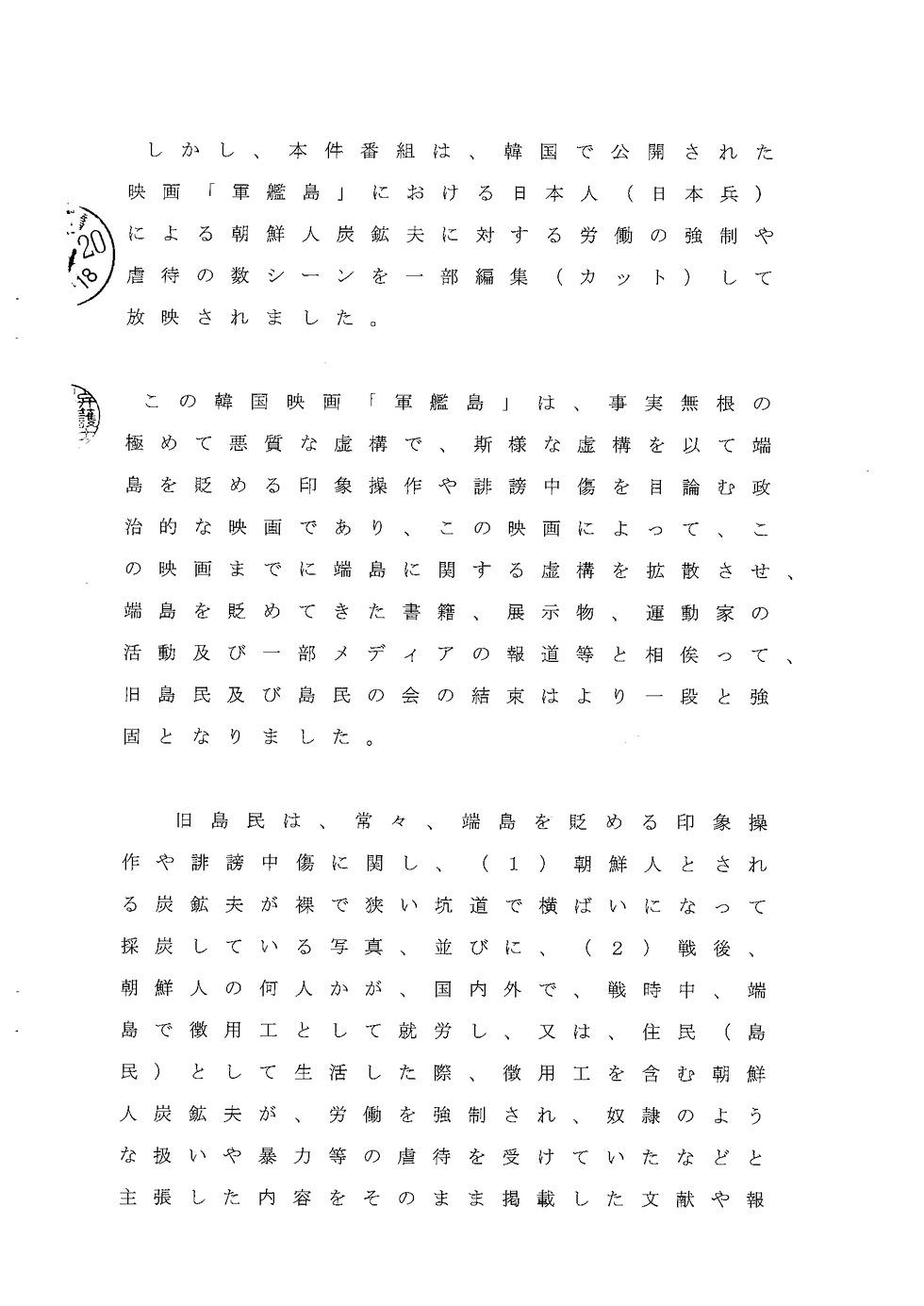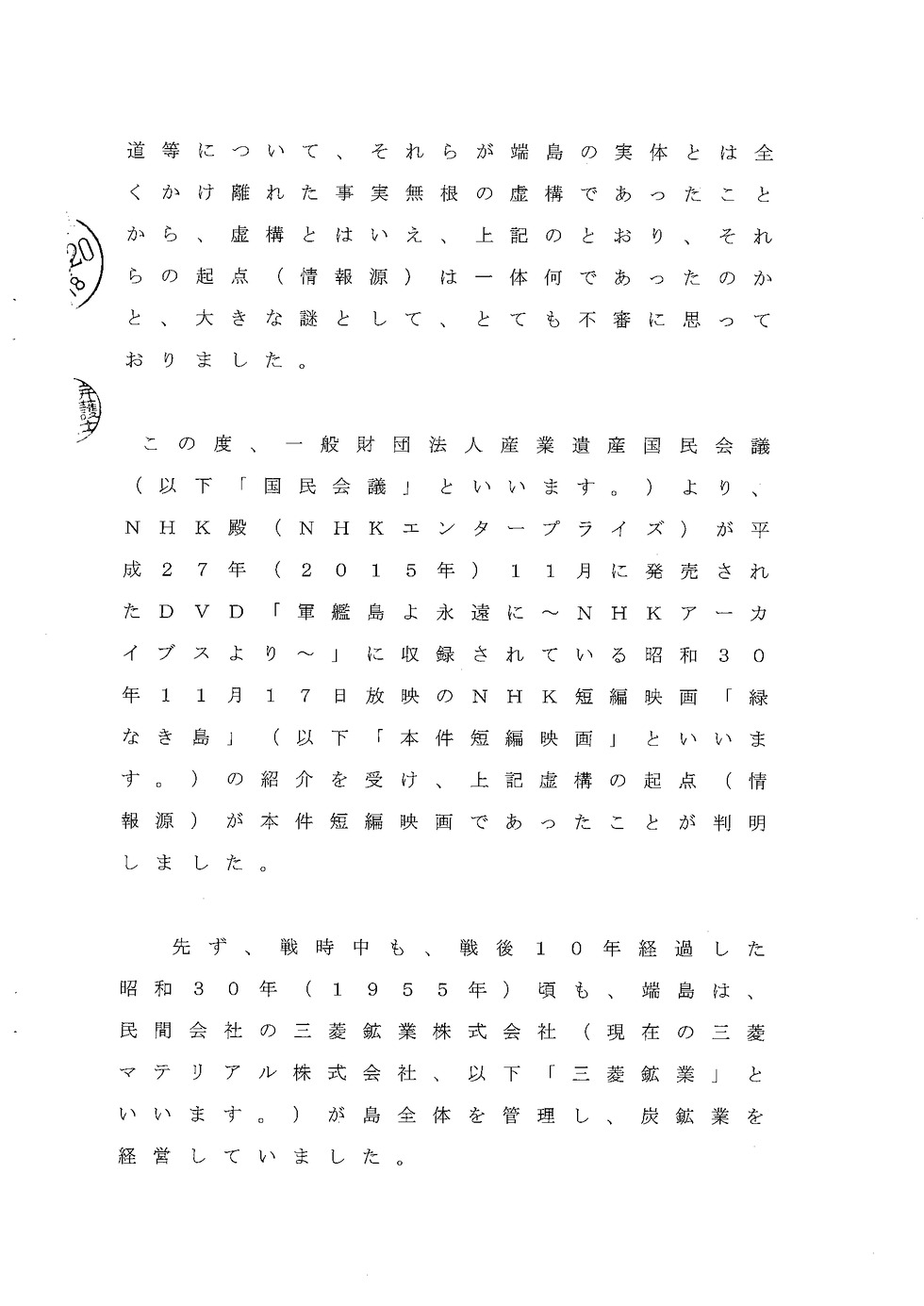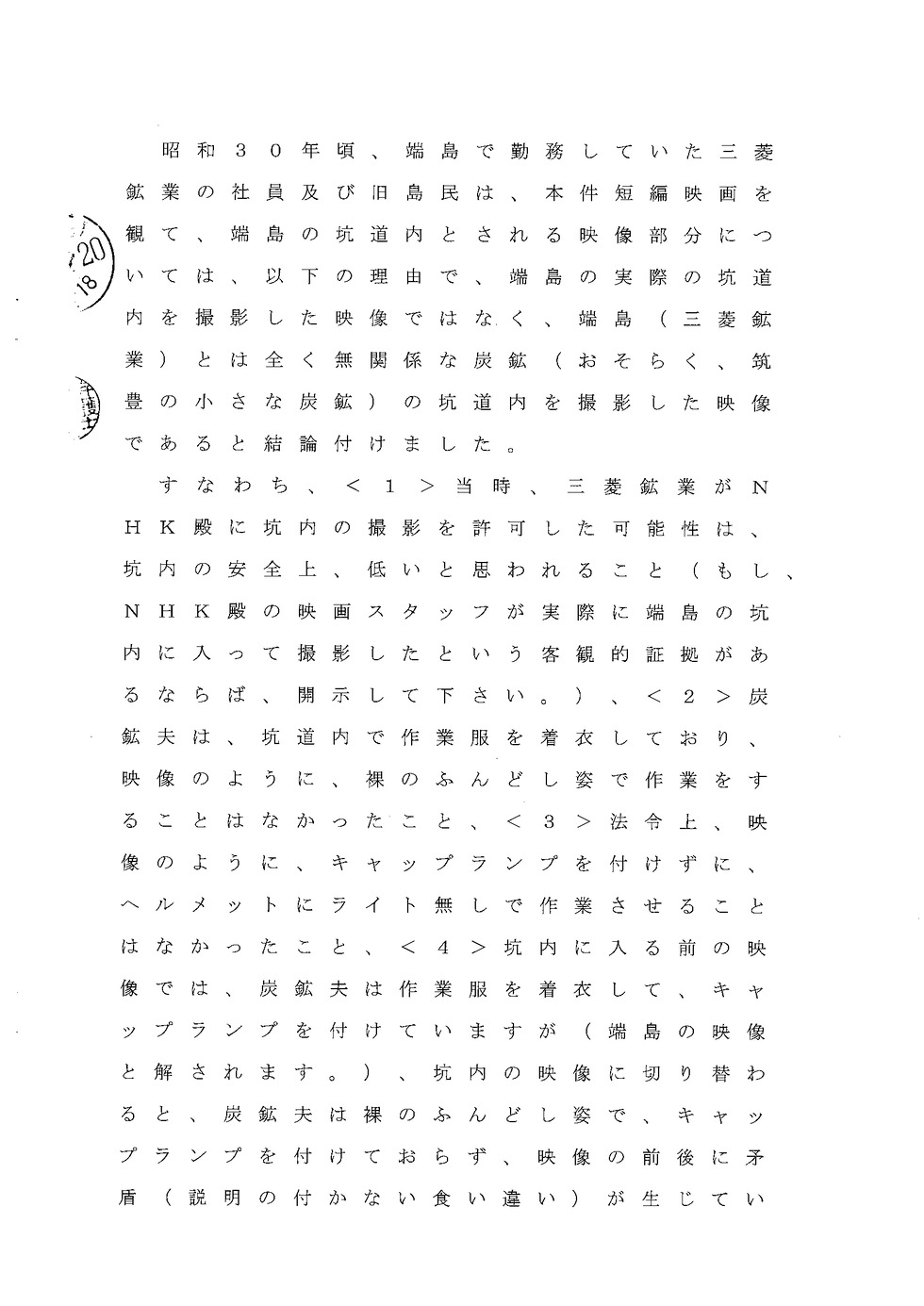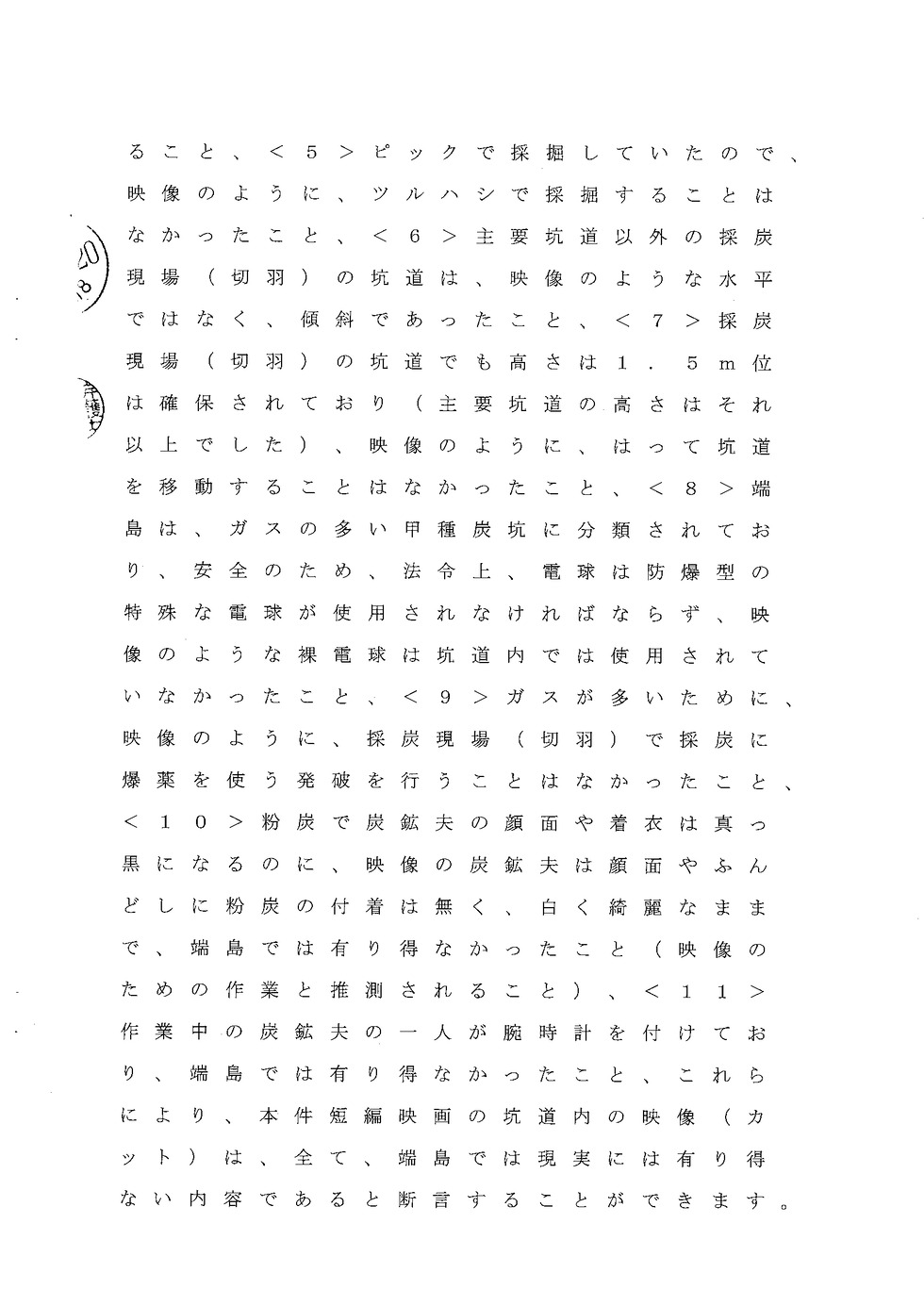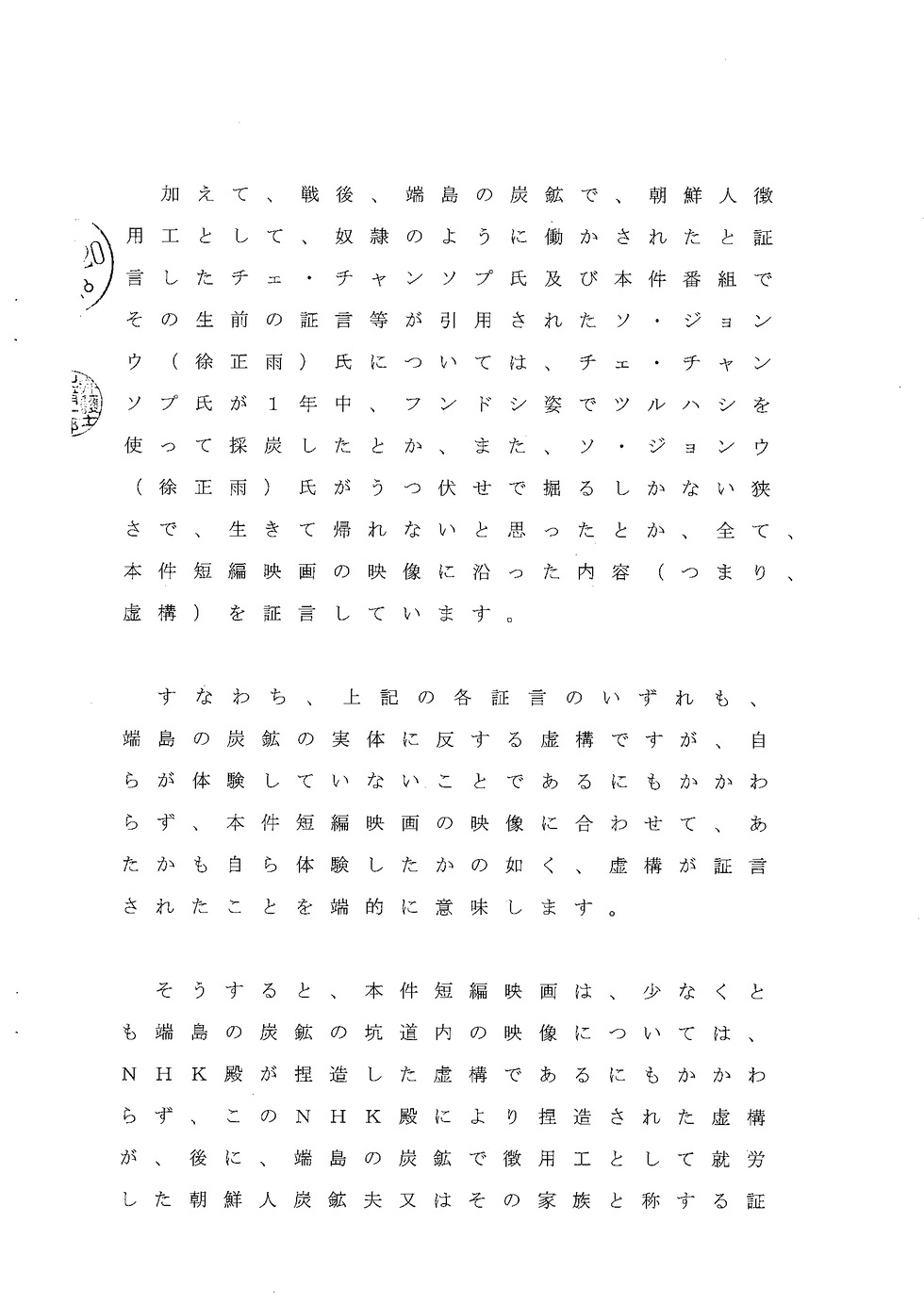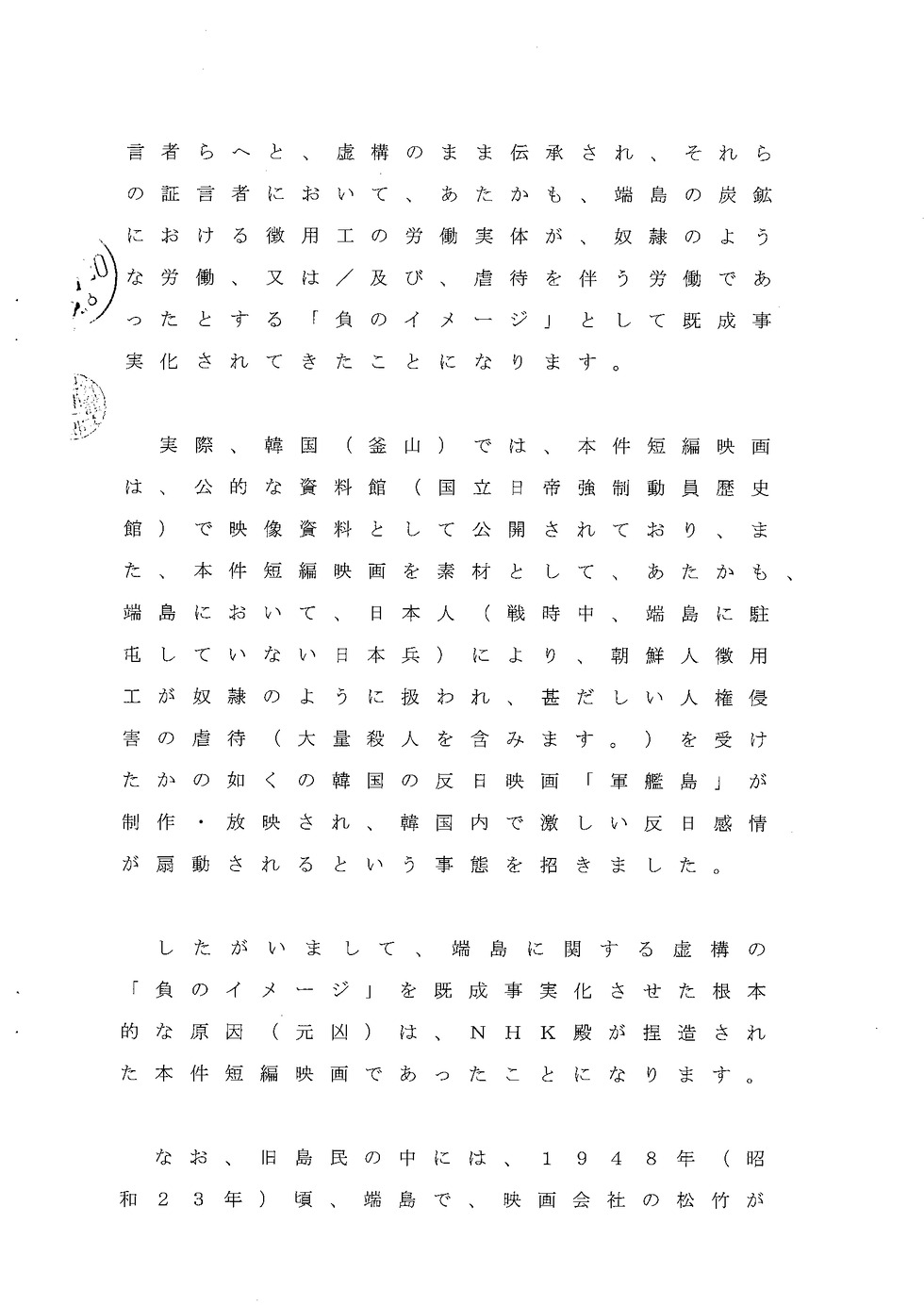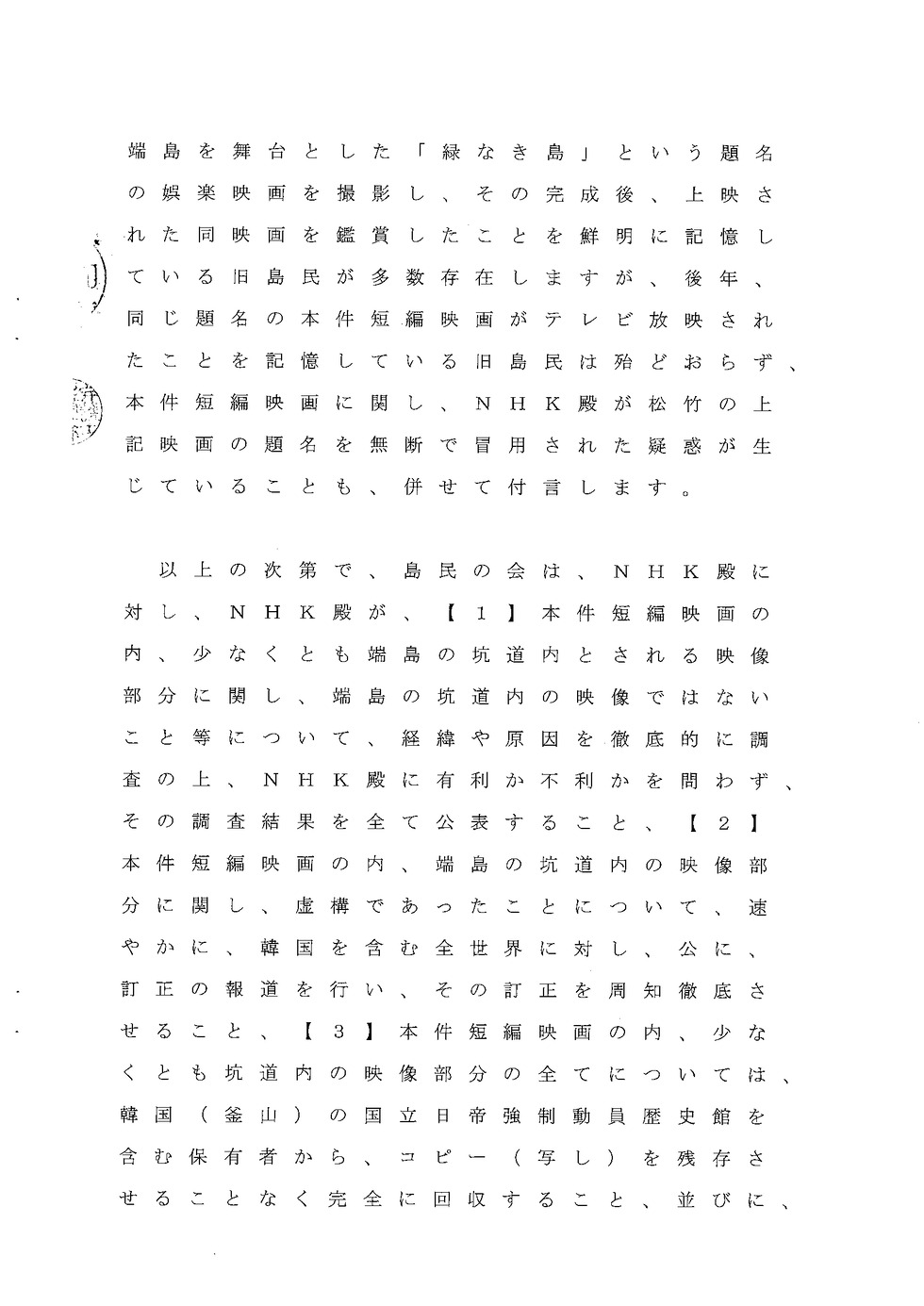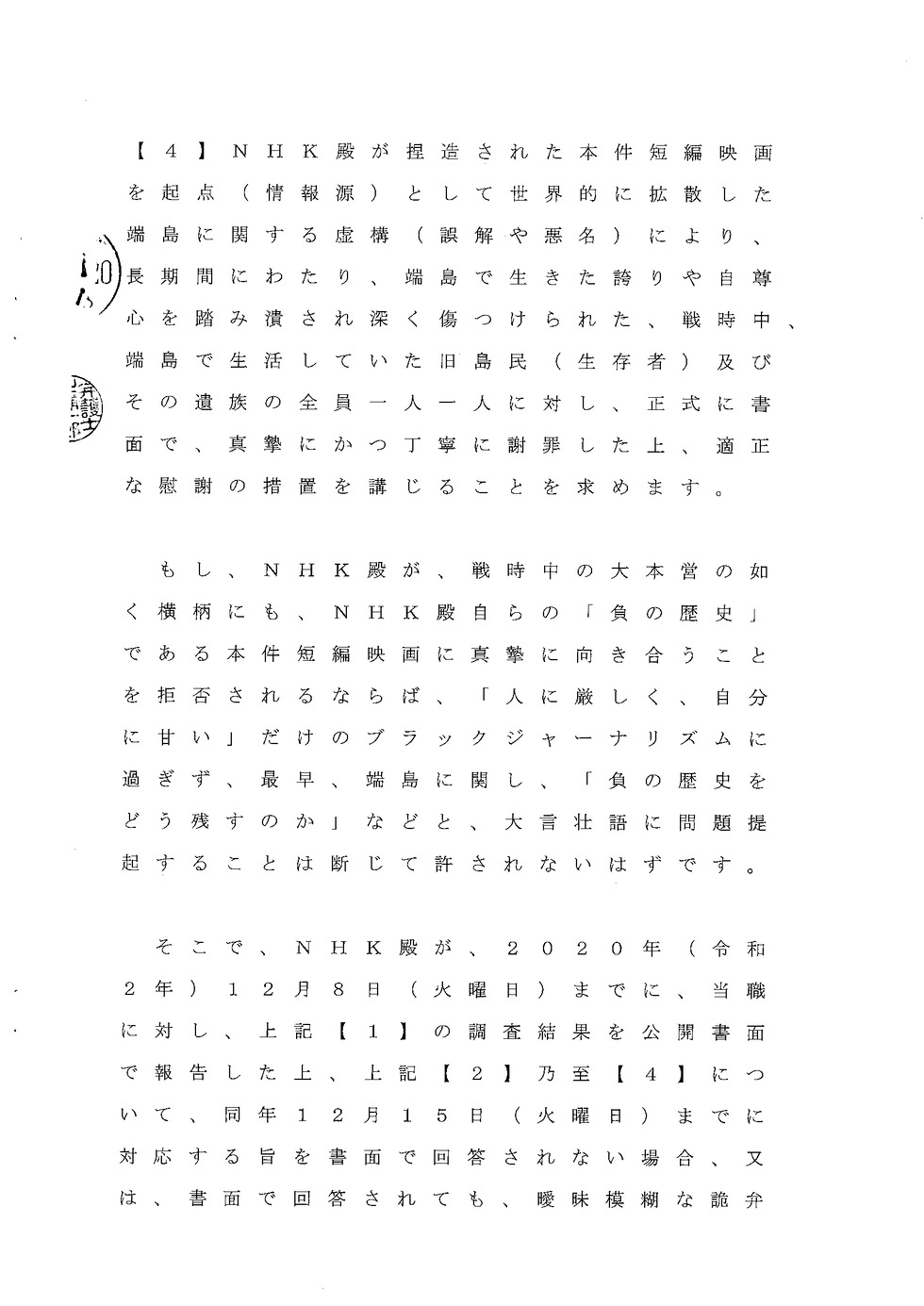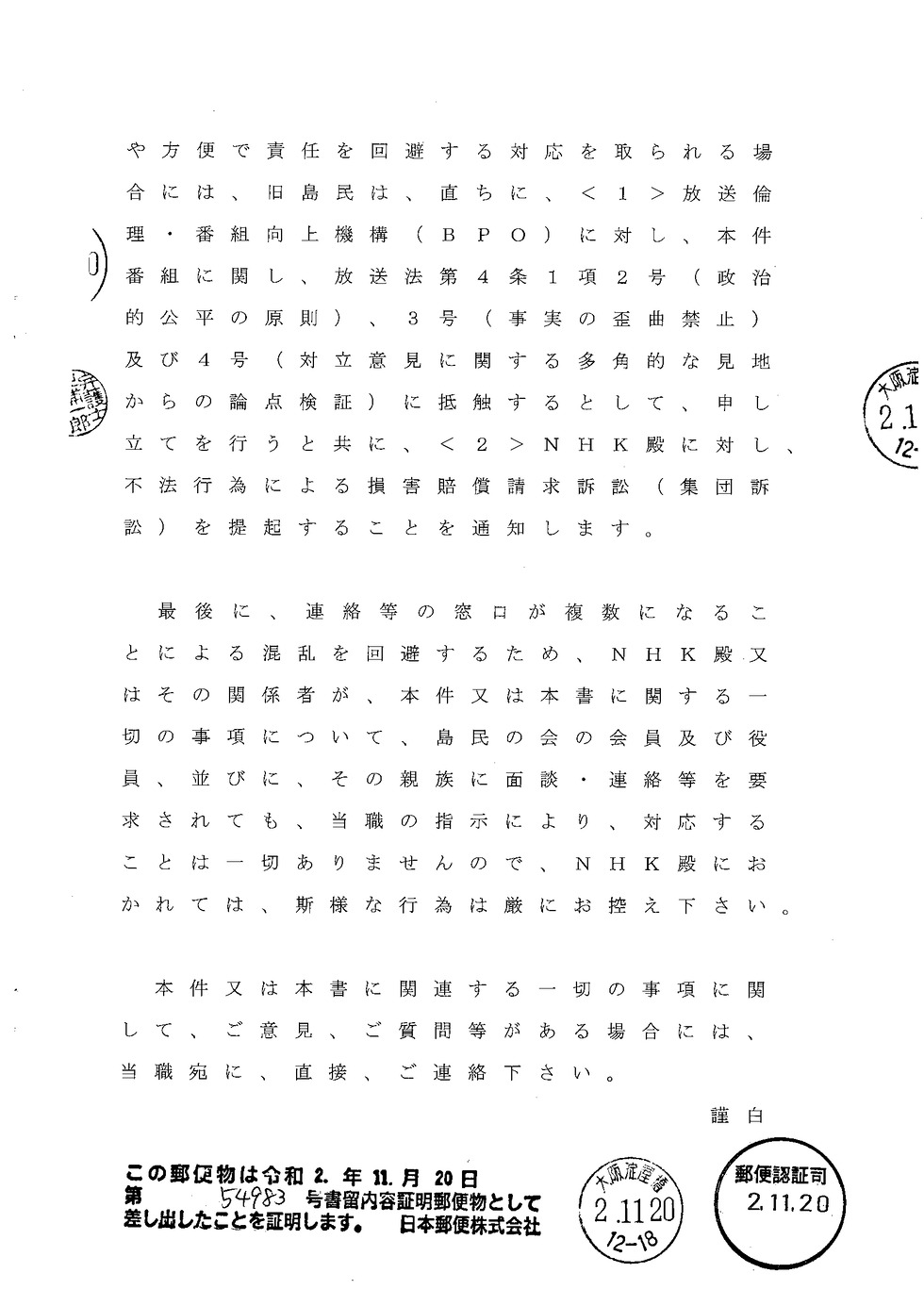Page 1
Page 2
Page 3
Page 4
Page 5
Page 6
Page 7
Page 8
Page 9
Page 10
Page 11
Page 12
Page 13
Page 14
Page 15
The Letter of Protest and Demand
November 20th, 2020
2 Chome 2-1 Jinnan, Shibuya City, Tokyo, Japan
Japan Broadcasting Corporation
To: Mr. Terunobu Maeda, President
From: The Association of Hashima Island Residents for the Pursuit of Historical Fact
The Representative of the Association
4 Chome 3-6 Imabashi, Chuo Ward, Osaka City
Yodoyabashi NAO Building 9th floor
Legal Professional Corporation T&S (弁護士法人トラスト&サービス)
TEL 0 6 - 6 2 29 - 88 11
F A X 0 6 - 6 2 29 - 1 2 0 0
Lawyer, Ichiro Kitaura
I would like to take this opportunity to express my sincere gratitude for your continued support.
Sincerely yours,
This is to inform you that we, Ichiro Kitaura, Attorney-at-Law, hereby submit this letter of protest (which hereinafter will be referred to as the “Letter of Protest”) to the Japan Broadcasting Corporation (which hereinafter will be referred to as “NHK”) on behalf of the “Association of Hashima Island Residents for the Pursuit of Historical Facts” (which hereinafter will be referred to as “the Association of Island Residents”).
The Association of Island Residents is located on Hashima Island in Nagasaki City (which hereinafter will be referred to as “Hashima Island,” which is also commonly known as “Gunkanjima”). The members of the association are former island residents and their descendants and relatives who worked or lived on Hahsima Island until it became uninhabited in 1974. The purpose of this project is to confirm the true history of Hashima Island, to pass on the real life of Hashima Island to future generations correctly, and to disseminate the real life of the former island residents of Hashima Island to people in Japan and abroad accurately based on the facts they have experienced through their real life on Hashima Island or the materials that the association possess.
For a long time, during the war (which hereinafter will be implying the time during the Pacific War), there are books, exhibits, and activities of activists that displayed the fiction in relation to Hashima Island. For example, Korean coal miners and their families (including their elementary school classmates, other Korean infants, and school students) were discriminated against like slaves from other Japanese miners and their families. Moreover, they were also forced to work and mistreated by the Japanese under harsh working and living conditions. This information is completely different from the reality of Hashima Island at the time, and are fictions that have no basis in fact. In addition, this information was broadcasted through media coverage and other information technology, and these irresponsibly propagated such fictions to the public without confirming them with the former island residents.
As a result, each of the residents, regardless of whether they are members of the Association of Island Residents or not, have suffered a great deal of mental anguish as their pride and self-respect—which they had gained through a life of working properly, learning and growing up in happiness, and living earnestly as human beings with the Korean miners and their families—, have been crushed.
In particular, since the registration of the “Sites of Japan’s Meiji Industrial Revolution” by UNESCO in July 2015, the proliferation of fiction in regards to Hashima Island has become so heated that the former island residents can no longer ignore the situation.
In January 2017, volunteers of the former island residents established the Association of Island Residents as a private organization located in Nagasaki City, with the purpose of addressing the situation where misunderstandings and bad names in relation to Hashima Island are spreading and worsening through books, exhibits, activities of activists, and other media broadcast that contain fictions in regards to Hashima Island.
At present, there are more than 40 members, even if the membership is limited to former island residents (survivors) who have lived on Hashima Island, with Sakae Matsumoto as the Honorary Chairman, Hideo Kaji as Chairman, Yoichi Nakamura as the executive head, and Azuma Ishikawa as the head of the office.
As mentioned above, the Association of Island Residents and other former island residents have been concerned about the current situation where misunderstandings and bad names in relation to Hashima Island have been spreading, however, we have always believed that we must find out the truth in terms of where (the source of the information) in the world these misunderstandings and bad names originated and who ought to be responsible for the creation of the fiction in regards to Hashima Island.
First and foremost, on October 16th, 2020, the Fukuoka Broadcasting Station of NHK launched a new program titled the “Island of Remembrance: Shaking ‘Historical Inheritance’” (which hereinafter will be referred to as “the program”), which was aired under a broadcast frame named “The Realization!” (実感ドド!). This program was aired under the theme of coal mine labor on Hashima Island during the wartime, and it was based on the issue (raising a problem???何が言いたい?) of “how to preserve negative history,” which was personally set by NHK themselves.
According to the testimonies (video interviews), documents (diaries and other records), and other sources of former island residents in regards to their lives (including coal mining) on Hashima Island during and immediately after the war, which can be viewed at the Industrial Heritage Information Center introduced in this program, there were Korean coal miners who came to Hashima Island of their own free will from the Korean Peninsula during the wartime (some of them were family members). Moreover, there were also Korean coal miners who had been conscripted to work on Hashima Island, as well as the fact that Korean and Japanese coal miners worked together cooperatively in the same work teams. Many of the former island residents testified to this fact.
In addition, more than 70 of the former island residents have already been interviewed and testified that there was no mistreatment of Korean coal miners, including the so-called “conscripted workers,” and that they were not forced (or coerced) to work in a manner that discriminated against them compared to that of Japanese coal miners.
The testimonies that have not yet been made public will be made available at the Industrial Heritage Information Center in the future.
As mentioned above, there is absolutely no evidence that Korean coal miners were forced to work in a dangerous condition as if like slaves, or were forced to live like slaves, or were mistreated by the Japanese at the mine site or outside the mine in Hashima Island during the war.
However, this program was aired with some scenes partially edited (and cut) of forced labor and abuse of Korean coal miners by Japanese people (specifically Japanese soldiers) in the movie titled “Gunkanjima,” which was released in Korea.
This Korean movie named “Gunkanjima” is a very pernicious fiction that has no underlying basis in factual information, and it is also a political film that aims to manipulate impressions and slander the name of Hashima Island by using such fictions. This movie, together with the books, exhibits, activities of activists, and some other media reports that have spread fictions in regards to Hashima Island and slandered the name of the island, has further strengthened the unity of the former residents of Hashima Island and the Association of Island Residents.
The former island residents have always been concerned about the manipulation of impressions and the slandering of Hashima Island, and have often wondered what the origin (source) of the information of these fictions. They have especially questioned the sources of the following: (1) photographs of alleged Korean coal miners naked and lying down in narrow tunnels to mine coal, and (2) the fact that there were documents, news reports, and other materials that directly published the claims made after the war by some Korean people, both in Japan and abroad. They stated that when they used to live as residents (islanders) on Hashima Island during the wartime, people who worked as conscripted workers and other Korean coal miners were forced to work, treated like slaves, and were subjected to violence and other abuses. Since these were fictions with no basis in fact and were completely different from the reality of Hashima Island, we would like to know where did these stories come from and originate.
The National Congress for Industrial Heritage (which hereinafter will be referred to as the “National Congress”) has introduced the NHK short film named the “Greenless Island” (which hereinafter will be referred to as “the short film”) aired on November 7th, 1955, which is included in the DVD entitled “Here, Forever Lies Gunkanjima: From the Archives of NHK” released by NHK Enterprise in November 2015. It, in fact, turned out that this short film was the starting point (the source of the information) for the fiction mentioned above.
First of all, both during the war and around 1955, ten years after the war, the entire island of Hashima Island was managed by a private company named Mitsubishi Mining Co., Ltd. (which is currently known as Mitsubishi Materials Corporation, and it will be hereinafter referred to as “Mitsubishi Mining”). This company managed the entire island and operated a coal mining business.
The employees of Mitsubishi Mining and former island residents who worked on Hashima Island around 1955 watched the short film in question and concluded that, for the following reasons, the portion of the film purporting to show the inside of the mine on Hashima Island was not that of an actual one on Hashima Island, but inside of a coal mine (probably a small coal mine in Chikuho) that had absolutely nothing to do with Hashima Island (or Mitsubishi Mining).
In other words, <1> it is highly unlikely that Mitsubishi Mining would have allowed NHK to film inside the mine at that time due to safety concerns of the mine (if you have any objective evidence that the film crew of NHK actually entered the mine on Hashima Island, please disclose it). <2> The miners wore work clothes inside the mine, so they did not work naked in just their loincloths as shown in the film. <3> According to the laws and regulations, the miners were not legally allowed to work without cap lamps or without lights on their helmets as shown in the film. <4> In the film prior to entering the mine, the miners were clothed in their work clothes and wearing cap lamps (which can be interpreted as the actual footage from Hashima Island), but when the video switches to footage from inside the mine, the miners are shown naked in only their loincloths and are not wearing cap lamps, which creates inconsistencies (unexplained discrepancies) before and after the video. <5> Miners were mining with picks, not with pickaxes as shown in the video. <6> The mining tunnel at the excavation sites (the face of a wall of coal ore) except for the main tunnel was not in level and flat as shown in the video, but were sloped. <7> Even the height of the tunnels at the coal mining site (the face of a wall of coal ore) was at least 1.5 meters (the main tunnels were even higher), so there was no need to move through the mining tunnels by crawling, as shown in the video. <8> Since Hashima Island was classified as a Class-A coal mine with a lot of gas, special explosion-proof light bulbs were required by law to be used for safety reasons, and bare light bulbs like the ones shown in the video were not used in the mines. <9> Due to the high level of gas emission, explosives were not used for blasting at the excavation site (the face of a wall of coal ore) as shown in the video. <10> The coal miners in the video had no coal dust on their faces or loincloths, and remained white and clean, although their faces and clothes were completely blackened by the coal dust, which would not have been the case on Hashima Island (presumably because they were working for the video). <11> One of the miners was wearing a wristwatch, which would not have been possible on Hashima Island. As a result, we can conclude that all the footage (cuts) inside the mine displayed in this short film is something that would not have been possible in reality, and hence, are unrealistic for Hashima Island.
As described above, all the footage (cuts) in the short film that is said to be inside the mines of Hashima Island were shot in other coal mines (presumably a small coal mine in Chikuho), and hence, it shows that this footage of other coal mine was edited by NHK to include footage of Hashima Island along with it. In short, it seems that NHK intentionally (deliberately) fabricated the situation inside the mines of Hashima Island in this short film.
The Association of Island Residents strongly protests against the acts of fabrication committed by NHK on this short film, as mentioned above.
In addition, according to the research conducted by the National Congress, the photographs of Hashima Island taken during the wartime, specifically the photographs of alleged Korean coal miners lying down naked on his side in narrow mining tunnels at a coal mine on Hashima Island during the wartime, are proven not to be a picture of Hashima Coal Mine. Through the research, it has already been proven that the photo was taken at a small coal mine in Chikuho in the Showa 30s (1955-1965) after the war, and has nothing to do with either Hashima Island or the Korean conscripted workers. These pictures are often cited in literature critically introducing Hashima Island, and which have been widely reported or publicized in Korea.
Furthermore, with regard to all the testimonies of Mr. Choi Changsub, who testified that he was forced to work as if like a slave as one of the Korean conscripted workers in the coal mines of Hashima Island after the war, and Mr. Seo Jung-woo, whose testimony prior to his death was quoted in the program in question, has been proven that these are based on the theme of the short film (which is fiction). Mr. Choi Changsub said that he mined coal all year round wearing merely a loincloth and using a pickaxe, and Mr. Seo Jeong-woo testified that he thought he would not make it back alive due to the cramped conditions in which he had to dig face down.
In other words, each of the aforementioned testimony is that of a fiction that contradicts the reality of the coal mine on Hashima Island, but even though they did not actually experience it themselves, they testified to the fiction as if they had experienced it to go along with the footages in this short film.
This means that even though the short film is a fiction fabricated by NHK, at least with regard to the footage in the mining tunnels of the coal mine on Hashima Island—which is also a fiction fabricated by NHK—was later passed on in its fictional form to the witnesses who claimed to be Korean coal miners who worked as coscripted workers in the coal mine on Hashima Island, or who claimed to be a family member of one of these conscripted workers. It has been, in fact, falsely passed down as if the actual labor of the conscripted workers in the coal mines of Hashima Island consisted of slave labor and/or abusive labor, and hence, this “negative image” turned into an existing fact.
In fact, in South Korea (Busan), this short film is shown as a visual material in an official museum (known as the National History Museum of Forced Mobilization under Japanese Occupation). In addition, using this short film as source material, the Korean anti-Japanese film titled “Gunkanjima” was produced and aired as if the Korean conscripted workers were treated like slaves on Hashima Island by the Japanese (they are talking specifically about Japanese soldiers here, but they were, in fact, not stationed in Hashima Island during the wartime), and were subjected to serve gross human rights abuses (including mass murder). As a result, it later led to the incitement of intense anti-Japanese sentiment in Korea.
Therefore, the root cause (the main cause) of the falsified “negative image” of Hashima Island can be said to be partially due to the short film that was fabricated by NHK.
In addition, there are many former island residents who still vividly remember how they watched the film when it was aired after its completion around 1948. It was an entertainment film titled, the “Greenless Island” in regards to Hashima Island, which was a film also set in Hashima Island. It was a movie shot by a film company named Shochiku. However, there are barely any former island residents who remember that a short film with the same title was broadcasted on TV later in the year, and I would also like to add that there are suspicions that NHK appropriated the title of the above-mentioned film by Shochiku without permission.
In light of the above, the Association of Island Residents calls on NHK to: [1] conduct a thorough investigation into the circumstances and causes of the fact that at least a portion of the short film purported to be from inside the mining tunnels of Hashima Island is not an actual footage from inside the mining tunnels of Hashima Island itself, and publish the results of the investigation, whether favorable or unfavorable to NHK; [2] have the fictional part of the short film—the portion of the short film that depicts the mining tunnels on Hashima Island—to be immediately corrected and that correction to be publicly announced to the world, including Korea, and to be made known to all; [3] Have at least all of the footage of the mining tunnels in this short film be completely recovered from its owners, including the National History Museum of Forced Mobilization under Japanese Occupation located in Korea (Busan), without any copies remaining; [4] Make a formal, sincere, and polite apology in a form of writing to each and every former island residents (survivors) who lived on Hashima Island during the war and also to their bereaved family members, who have also been deeply hurt and had their pride and self-respect crushed as well over a long period of time due to this fiction (as well as misunderstanding and infamy caused by this) in relation to Hashima Island. This falsified history has been spread around the world through this short film fabricated by NHK, which essentially acted as the starting point (one of the sources of information) for the proliferation of incorrect information. We request that you take appropriate measures for their comfort.
If NHK overbearingly refuses to earnestly face the issue associated with this short film—which in its own is a “negative history”--with the same arrogance as that of the Imperial Headquarters during the war, then it is nothing but black journalism that is “hard on others but soft on themselves.” Hence, it ought not to be allowed for them to talk big by posing the problem of “how to preserve the negative history” of Hashima Island.
For these reasons mentioned above, if NHK does not report the results of the above [1] investigation to us in a public document by Tuesday, December 8th, 2020, and respond in writing to the aforementioned [2] to [4] by Tuesday, December 15th of the same year, or even if they do respond in writing, we will not be able to accept their use of any vague, sophomoric, misleading, or subterfuge-like statements in order to avoid responsibility. If they do not comply with these conditions, the former island residents shall immediately <1> file a complaint with the Broadcasting Ethics and Program Improvement Organization (BP0), claiming that the program in question violates Broadcasting Act Articles 4, Paragraph 1, Act No. 2 (principle of political impartiality), Act No. 3 (prohibition of distortion of facts), and Act No. 4 (the points at issue must be verified from multiple perspectives where there are opposing opinions concerning an issue). Moreover, <2> we hereby notify NHK of our intention to file a class action lawsuit against them for compensating damages against their unlawful act.
Finally, in order to avoid confusion caused by multiple points of contact, we will not respond to any requests from NHK or its related parties to meet or contact any member or official of the Association of Island Residents or their relatives in regards to any matter related to this case or this document.
If you have any comments or questions in regards to this matter or any matters in general related to this document, please contact us directly.
Sincerely yours,
I hereby certify that this mail was sent by registered mail No. 54983 on November 20th, 2020. By Japan Post Co., Ltd.


